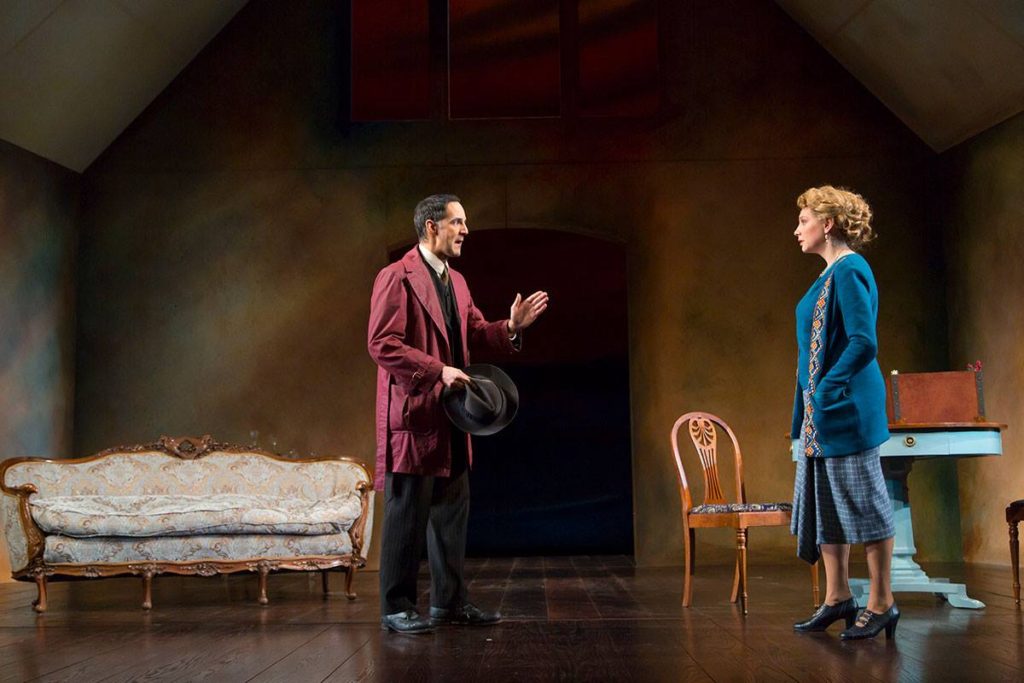
Nael Nacer and Andrea Syglowski in “A Doll’s House;” Photo: T. Charles Erickson. Sh!t is about to get real.
Presented by Huntington Theatre Company
Written by Henrik Ibsen
Adapted by Bryony Lavery
Directed by Melia Benussen
Jan. 6 – Feb. 5, 2017
Avenue of the Arts
BU Theatre
Boston, MA
Huntington on Facebook
Review by Kitty Drexel
“If your laws don’t include me, well then, they don’t apply to me either.”
Anita Crown, Bad Girls
(Boston, MA) A Doll’s House (AHD) is a classic tragedy of manners. It features a female protagonist, and has feminist themes. On paper, it’s a strong educational tool. Its presentation on the stage is another matter entirely. ADH is a show with chatty dialogue that wiggles around its points like a Mexican jumping bean. The Huntington’s modernized production with updated script drags from the emotional constipation of its characters. Not even Bryony Lavery could salvage this one.
AHD is about a woman so crippled by her gendered role in society that she crashes from her high pedestal after a momentary lapse in judgement. Nora (Andrea Syglowski) is a sheltered but charming housewife with a secret. She illegally borrowed money from Krogstad (Nael Nacer) to save her husband, Torvold’s (Sekou Syglowski) life. Krogstad blackmails Nora. Nora must either convince Krogstad to forgive her indiscretion, or lose the life of safety she’s always known. Expectations are shattered, and integrities are challenged. Marinda Anderson as Mrs. Linde, and Jeremy Webb as Dr. Rank complete the leading cast.
This dry, slow show is a result of many pieces that work well alone but don’t meld together. For example, Syglowski plays Nora at a furious, mind-numbed pace. She speaks so quickly that she can’t think beyond them. She weaves a protective cocoon of words around herself to prevent others from reaching her. It’s a bold, symbolically heavy choice that alienates the audience. We are too emotionally distanced from Nora to sympathize with her. Further, because the actors are so removed from our lead, they are distant with each other as well. It appears as if they’re all performing in different plays.
Syglowski does not make Nora approachable. Ibsen writes Nora that way; she doesn’t want to be approached lest her true misery be discovered. Syglowski, allowed a limited range, is forced into a precedent of minimal emotional connection those around her. That includes her audience. The other actors follow suit. We are alienated a second time because we can’t connect to the other actors as well.
By existing as Krogstad, Nacer crashes through the tepid civility so drilled into ADH. We weren’t merely waiting for conflict. In ADH’s world of polite mansplaining gussied up as “truth,” we are desperately waiting for an unscrupulous backbone to pick a fight. Nacer has the necessary presence to provide it (even if he upstages his fellow cast members).
The set backdrop looks like an Edvard Munch painting because it is designed to look like one. Watching the characters interact against this backdrop is unsettling. James Noone’s design evokes the violence and life of Munch’s works. It is not altogether pleasant, but neither Ibsen’s nor Munch’s works were intended to be.
This play is ripe with markers of deeply sexist, abusive behaviors. One could play a decent game of feminist BINGO trying to tag them all: gaslighting, belittling, objectifying, fund denial, emotional disturbance, mansplaining, tantrums, rape, anger management issues, beneficial sexism, seclusion, emotional and physical abuse, etc. Please watch accordingly.
Theatre is a dog-eat-dog world. This is not the Huntington’s best work yet they deserve some credit for working outside of their comfort zone. In its parts, A Doll’s House works very well. Risks were taken but they didn’t pan out.
Queen’s Note:
Today’s the day! At 12:00PM, we elect an pointless piece of orange orangutan dookie, a thin skinned, micro-penised bigot to the office of the President. His plan to slash the National Endowment for the Arts and the National Endowment for Humanities is HERE (vs. the monstrous defense budget). Trump is a bad, terrible man. His policies are destructive. His narcissistic behavior is worse. Fight him. And, for the love of all that’s sacred, keep creating. If you need help, ask for it. Our existence is our resistance. May the force be with you.
– KD
#blacklivesmatter #translivesmatter #brownlivesmatter #yellowlivesmatter #lgbtqialivesmatter #immigrantlivesmatter #muslimlivesmatter #disabledlivesmatter #theatreartsmatter #NODAPL
